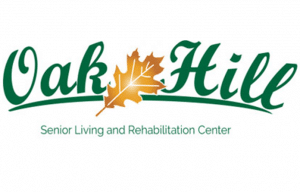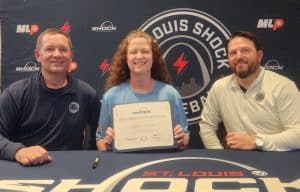Labor shortage affects EMS
Emergency service teams are not immune to the labor shortage plaguing the nation, and, as many can testify, having such small staffing on top of a pandemic can be especially daunting.
Monroe County Ambulance Director Carla Heise said her department is currently looking for a full-time paramedic as well as part-time employees.
“Since the pandemic, we have been getting a lot less applications for our opening positions,” Heise said.
Columbia EMS Chief Kim Lamprecht said the city and Monroe County area has not been hit as hard as other areas. She attributes this to the community supporting emergency services, her position as an instructor for EMT classes at Southwestern Illinois College being a recruiting platform and more.
Even though she said the department is comfortably staffed, Lamprecht still can face issues with scheduling.
“I have six full-timers and I run two trucks daily,” Lamprecht said. “I fill a part-timer with my full-timers, so we’re very reliant on part-time paramedics and EMTs to fill those positions. My part-timers all work primary employment somewhere else, so since there’s this shortage across the board (the question becomes), ‘Why would you want to come here and pick up a shift at straight time when there are shortages in your own department and you can get overtime for it? That’s where I’m running into issues.”
MedStar Ambulance is a family owned and operated company that serves Randolph and the majority of Clinton and St. Clair counties. Charles Kelley, its chief operations officer, said the company is now operating with roughly 200 total EMTs and paramedics, leaving them hurting for more staff.
“Thirty more would make me feel a lot more comfortable because it would help ease the burden on the people that are working,” he said. “We just need some breathing room. These people need rest.”
MedStar has been trying a variety of initiatives to increase applicants – increasing wages and benefits – but is still not seeing the numbers it needs.
Long before the COVID pandemic, the number of individuals entering the workforce as EMTs or paramedics had been declining. With an ever-increasing demand on what knowledge and expertise they should possess, emergency service personnel are essentially learning the same skills as nurses and even physicians but are being paid much less, Lamprecht said.
She said this results in less students wanting to pursue the field.
For those who did set their sights on working in an ambulance, the pandemic made it even harder to achieve this goal.
“Online education for EMTs and paramedics is very difficult because we are very kinesthetic learners,” Lamprecht said. “We lecture, but we do a lot of hands-on (activities) and a lot of case scenarios to reinforce knowledge. So, it was very difficult when we had to go online in the beginning of 2020. I ended up with half of the class dropping.”
While Lamprecht typically had 40 students in her day classes, this number dwindled to 10 during pandemic times – with even fewer students actually qualifying to test.
MedStar and other agencies are paying individuals to take EMT classes in hopes of quelling this issue.
“MedStar is paying people to take EMT classes right now. We are getting ready to start our third class that we pay you to come to school for eight hours a day to become an EMT to come work for us,” Kelley explained. “We are not the only ones doing it. There are several other services across the entire state (who are). It’s a nationwide thing right now. We’re paying people to try to enter our profession.”
Prior to Gov. JB Pritzker announcing a vaccination mandate for this specific field, a MedStar class would average 17 students. Now, this figure is down to five.
With an unprecedented call volume in Monroe County, other parts of the state and many parts of the nation, an already small workforce is being stretched even thinner.
“In 2020 we ended the year with 2,428 calls,” Heise said. “We are on track to surpass 2,500 calls this year – the highest count the (Monroe County) services have seen.”
Kelley said today, MedStar experiences approximately 40 more calls a day than it averaged pre-pandemic, and calls to assist other agencies have also increased.
Heise added Monroe County has been called to assist other agencies more frequently this year as well.
“On average, we do EMS assist less than 100 times a year,” Heise said. “2021 was up 15 percent on EMS assists from 2020.”
Call volume appeared to settle for Columbia EMS earlier this year compared to prior pandemic times, but Lamprecht said December is seeing an uptick once again.
“There is no rhyme or reason to it,” she said of the phenomena. “We had a slight increase in potential COVID patients, but I wouldn’t say the increase is due to COVID.”
Kelley and Lamprecht both said the combination of higher call volumes and short staffing has hit some parts of the state – particularly those further south – in a very recognizable way.
“I know in (some parts) of Southern Illinois they’re struggling,” Lamprecht said. “Those are some poor communities, those are some very rural communities and those are also some communities that are staffed with volunteer EMS. So increased wait times for ambulances is a big thing (there) because they’re coming from other venues to provide that mutual aid.”
With virtually all departments being short emergency personnel in some capacity, Kelley said he fears what could happen if an influx of calls warrants mutual aid when other departments may not be comfortably able to manage their own calls.
“I’m going to knock on wood: At this point, we have been able to hold our own,” Kelley said, later continuing, “I know other services are running tight … So, would they be available if I called them? That’s a concern of mine. We help out all of our surrounding neighbors when they need help, and most of them reciprocate them all of the time. It’s been a very fluent system, but with everybody starting to hit these new levels of (short) staffing, will they be available if that big 10-car accident happens? That’s a harsh reality.”
Across the river, the staffing crisis has even more immediate, noticeable impacts, said Rebecca Hartman, a part-time paramedic for Columbia EMS and emergency room paramedic for South City Hospital in St. Louis.
“You call 9-1-1 and you expect to get an ambulance. In St. Louis City, they’re waiting hours for ambulances,” Hartman said. “If they’re not a priority call, then sometimes we’ll have police officers bring patients in and drop them off.”
“Sometimes, (South City Hospital) is waiting for two or three days to have a transport come in to do a transfer from our facility to another one because there are not any ambulances able to come in and take it because they’re busy,” Hartman continued.
Kelley said so many St. Louis hospitals being close to capacity has led to MedStar receiving more transfer calls, sometimes being asked to transport patients to hospitals as far away as Evansville, Ind.
With many Monroe Counties seeking emergency help across the river, they may find longer emergency room waits.
Hartman said she has heard these can average between 4-8 hours.
“Just be patient,” Hartman said to anybody facing long waits in any area of health care. “It’s not just (EMS). It’s the hospitals, it’s the nursing homes … it’s all of health care. Everybody is tired; everybody is burnt out. They’re tired of working extra shifts; everybody is short – Columbia is not short, but every other agency is.”
Adding to the burnout from the need placed on health care is the immense amount of precautionary measures EMTs and paramedics have to take making their job even more difficult.
“Not only were we wearing the surgical or the cloth mask, in the beginning we were wearing gowns, gloves (and) N95s on top of them,” Hartman said. “They would make our faces break out, we’d have blisters underneath. Some of us were allergic to the materials and so we’d have like red rashes on our face and then you put heat on top of it from the summer. You’re working a cardiac arrests, or working a trauma or carrying some guy down flights of stairs, it’s already trying by when you’re trying to do it with all that gear on, it makes everything 10 times worse.”
For a while, those who were vaccinated were not required to wear masks on non-COVID related calls, but now crews are required to wear N95s on every call.
Full PPE equipment is required when aiding a COVID patient, Hartman said.
Other parts of the country are so saturated with calls and low on personnel that they are requesting help from other states, resulting in the Federal Emergency Management Agency pulling from agencies across the world to deploy health care personnel to supply manpower to these “hot spots.”
Hartman experienced this first hand during the first year of the pandemic. She was working as a paramedic for Abbott EMS when she was deployed to be part of the Emergency Disaster Team as a task force leader.
By the end of March 2020, Hartman was in New Jersey assisting with the New York-New Jersey deployment.
“The call volume there was absolutely insane,” Hartman recounted. “They had 9-1-1 calls pending when we got there – and I’m talking like 100s of 9-1-1 calls that were pending – (and) the wait time for ambulances was increased because of the sheer call volume that they were receiving that was 9-1-1 and COVID-related. Then you had the other people that were scared to go to the hospital because of COVID so they would wait until the last minute, (causing) the criticalness of the calls to increase.”
The departments Hartman and her team were assisting had personnel die from the disease weeks – and sometimes mere days – before her team’s arrival. Hartman said while being deployed, she even saw some of her own colleagues die from the disease or sustain life-long injuries from it.
“Not only were they facing an enormous amount of call volume, but they were also grieving the loss of their coworkers,” Hartman said. “They were working short-staffed anyway … and on top of that, they’re down half the staff that are there because they’re sick or their families are dying from it.”
In the span of March to December 2020, Hartman had been deployed to New Jersey, Miami and Minnesota to help systems overwhelmed with COVID. When Hurricane Laura hit, she traveled to Beaumont, Texas and the New Orleans area to help administer disaster relief while simultaneously helping battle the pandemic.
“The reason we were down there was because they were already backed up because of COVID, and then we took the 40,000-50,000 refugees from the hurricane and put them in hotels in downtown New Orleans,” Hartman said. “They couldn’t keep up with the call volume from the refugees being in the hotels, so that’s why we had 9-1-1 surge units in New Orleans.”
Hartman resigned from her position with Abbott in late December 2020, but said others are still being actively deployed to areas in need.
And while Hartman is now home, she said it’s impossible to leave what she witnessed entirely behind her.
“The hardest thing was coming back home and everybody that lived in … any place that wasn’t affected by it didn’t understand it,” Hartman said. “Some people thought COVID wasn’t real, and it was very real. It was very real for all of us who were there running hundreds of cardiac arrests a day. It’s hard to imagine that trauma that you go through, the mental exhaustion – nobody is made to see the stuff we saw on the street.”






